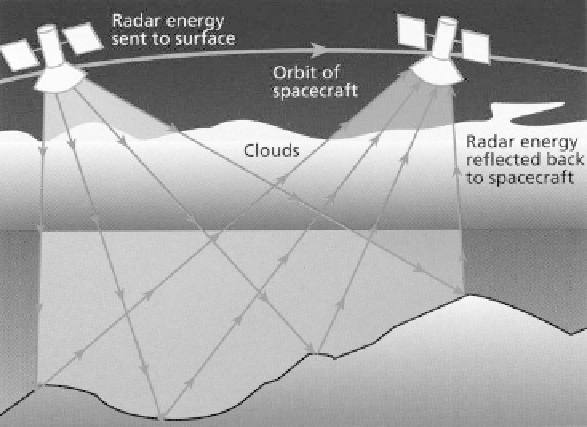Geology Reference
In-Depth Information
Figure 6.5. A diagram showing how data are collected for
radar imaging; pulses of radar energy are sent from the
spacecraft to the surface, where some energy is re
ected
back to the spacecraft, depending on the terrain, surface
roughness, and other factors. The signal is then
synthesized to produce images, such as those from the
Magellan mission.
Figure 6.6. Magellan used one antenna for radar mapping
and return of data to Earth; this diagram shows a typical
orbit for the mapping phase and the
phase to
Earth, with each phase separated by a short time when the
spacecraft was turned to face either Venus (for mapping)
or Earth (for downlink); observations of known stars were
used to determine the precise position of the spacecraft, a
technique commonly used in planetary missions.
“
downlink
”
consider core formation and solidification to still be taking
place now.
Given the overall interior con
guration, we might spec-
ulatethattheplanethasamagnetic
field, but in fact it does
not. Although it is tempting to suggest that the slow rotation
rate of Venus precludes an Earth-like dynamo, geophysical
models indicate that this cannot explain the lack of an active
magnetic
field, and its absence remains a puzzle.
The topography of the venusian upland plateaus appears
to be isostatically compensated, suggesting crustal thick-
nesses of 20
-
40 km. As reviewed by planetary geophysicist
Sue Smrekar and colleagues (Smrekar et al.,
2007
), the very
low water content inferred for the interior from the Pioneer
Ve nu is data is thought to have a large in
uence on the rheol-
ogy of the interior materials. For example, the low water
content would suggest a much stronger lithosphere than on
6.3 Interior characteristics
Information is very limited for the interior of Venus. In the
absence of seismic data, we must use geophysical models
that are based on (1) planetary characteristics (such as
orbit and spin periods), (2) gravity distributions, (3) top-
ography, and (4) surface compositions. For example, com-
positional measurements from the Venera and Vega
landers indicate that basaltic plains and possibly more
silica-rich uplands exist, supporting the notion that
Venus has experienced differentiation. Thus, because it
is a rocky object of nearly the same size as Earth, it is
likely that Venus has a core, mantle, and crust and that
radioactive materials generate interior heat. Some planet-
ologists suggest
that
the core is solid, while others





